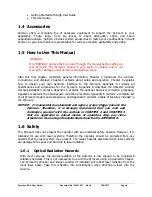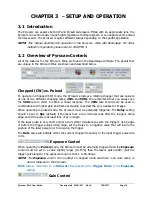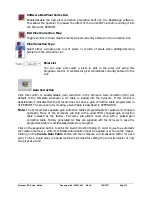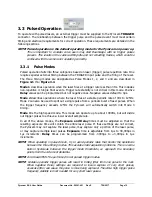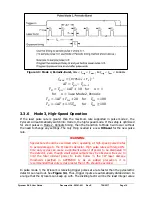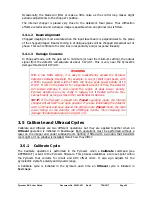
Pyrocam III
HR
User Guide
Document No. 50361-001
Rev E
7/18/2017
Page 17
be contained within the programmed
Exposure
time. In general, you should program the
Exposure
time to extend 10-15% longer than the actual laser pulse width.
To remain in mode 1, you must restrict your trigger rates to be <3Hz. The Pyrocam
automatically switches from Mode 1 to Mode 2 if the trigger rate meets or exceeds 3Hz.
Figure 3.1 : Mode 1, Single Shot,
𝒇
𝒕𝒓𝒊𝒈
< 𝟑𝑯𝒛
𝑇
𝐸
= 𝑇
𝑙𝑤
+ 20
for
𝑇
𝑙𝑤
< 100
𝑇
𝐸
= 1.15 𝑇
𝑙𝑤
for
𝑇
𝑙𝑤
≥ 100
3.3.4
Mode 2, Periodic Operation
In Mode 2 trigger pulses must arrive at a periodic rate. Refer to
. The
Exposure
time should be set to contain just the pulsed event to be captured. If the exposure time is set
too long (after the pulse) it will result in a loss of signal due to array cooling before detector
readout.
If the trigger source is unstable or turns on and off, some loss of uniformity shot to shot will
likely result. For best operation, calibrate the Pyrocam at the trigger rate being used and
recalibrate if the rate changes.
In mode 2 and 3 the Pyrocam firmware measures the trigger pulse period and predicts when
the next pulse will occur. Based on the predicted trigger time, the exposure start time can be
advanced (made early). When a negative
Delay
is entered, the exposure time will start early
based on the negative
Delay
value. This early exposure start time will compensate for lasers
that fire at or before the trigger pulse’s arrival at the Pyrocam. It can also compensate for
pulse to pulse jitter when the pulse rate is less stable.
For lasers with very short pulse times (10µs or less) that start at the triggers rising edge,
some amount of negative
Delay
is required to capture the pulse. Without it, the pulse will
occur prior to the exposure window being able to open.




